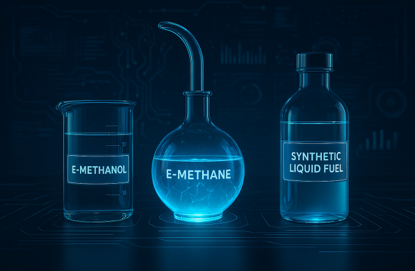Introduction
The escalating global concern over climate change, primarily driven by carbon dioxide (CO₂) emissions from fossil fuel combustion, underscores the urgent need for sustainable alternatives in the transportation and industrial sectors. In response, electrofuels (e-fuels) such as e-methanol, e-methane, and other synthetic liquid fuels have emerged as promising solutions. These fuels are produced by synthesising captured CO₂ with hydrogen gas derived from water electrolysis, utilising carbon-neutral electricity (OSHA, 2025). Their high energy density and compatibility with existing infrastructure make e-fuels particularly attractive for decarbonising sectors that are difficult to electrify, including aviation, shipping, and heavy industry, thereby supporting the global transition to a sustainable, net-zero future.
Fire and Explosion Hazards
However, the production of e-fuels introduces a unique set of fire and explosion hazards. The processes involved operate at high pressures and temperatures and utilise flammable and toxic gases, including hydrogen, methane, methanol, and ammonia. These conditions create a complex risk landscape that demands rigorous fire safety engineering and proactive risk management.
E-fuel production encompasses several chemical pathways (I. Ul Hassan 2025), each with distinct operational and safety implications. The methanation process, also known as the Sabatier reaction, combines CO₂ and H₂ to produce methane and water, operating at temperatures between 200–400°C and releasing significant heat. Another pathway involves the Reverse Water Gas Shift (RWGS) reaction followed by Fischer-Tropsch (FT) synthesis, which converts CO₂ and H₂ into carbon monoxide and subsequently into long-chain hydrocarbons suitable for liquid fuels. E-methanol and e-ammonia are also synthesised using CO₂ and H₂ or nitrogen, respectively, under high pressure and temperature conditions (I. Ul Hassan 2025).
The use of hydrogen presents unique challenges. Hydrogen has a wide flammability range (4–75% in air), low ignition energy, and burns with an almost invisible flame, making leak detection and suppression especially difficult. Methane poses significant explosion risks, particularly in confined spaces, while methanol is both flammable and toxic. Ammonia is corrosive, toxic, and can cause a Boiling Liquid Expanding Vapor Explosion (BLEVE) under certain conditions. The operational hazards are further compounded by high-pressure electrolysis units, hot catalytic reactors, and cryogenic storage systems, all of which require robust containment and venting mechanisms to prevent leaks and overpressure incidents.
Case Studies
Recent incidents underscore the importance of rigorous fire safety protocols. In 2020, a hydrogen storage facility in Ulsan, South Korea, experienced a catastrophic explosion due to a high-pressure hydrogen leak (FCW Team, 2025). The incident highlighted deficiencies in leak detection, emergency response, and separation distances. In 2019, a methanol storage tank fire in Gujarat, India, triggered by a lightning strike, revealed critical safety lapses, including the absence of proper grounding and foam-based fire suppression systems (Kuanal, 2025). In 2016, a BLEVE occurred at an ammonia storage tank in Chittagong, Bangladesh, following fire exposure, resulting in a toxic vapor release and mass evacuation (Press Trust of India, 2025).
Engineering Controls and Standards
To address these risks, several key standards and codes must be adhered to. NFPA 2 covers the safety aspects of hydrogen storage, handling, and leak detection. NFPA 55 regulates compressed gases and cryogenic fluids, while NFPA 30 governs the management of flammable and combustible liquids. Explosion venting and suppression are addressed by NFPA 68 and 69, and electrical safety in hazardous areas is covered by NFPA 70. Compliance with these standards is critical for the safe design and operation of e-fuel production facilities.
Effective fire safety in e-fuel production requires a multi-layered approach. Hazard identification methods such as HAZOP (Hazard and Operability Study), LOPA (Layer of Protection Analysis), and QRA (Quantitative Risk Assessment) are essential for understanding and mitigating risks. Continuous gas monitoring for hydrogen, methane, carbon monoxide, and ammonia, combined with robust ventilation systems, helps prevent the accumulation of flammable gases. Explosion protection measures include intrinsically safe equipment, explosion venting, and blast walls. Fire suppression systems—such as water deluge, dry chemical, and inert gas—must be tailored to the specific hazards of each fuel. Operational controls involve comprehensive training for personnel, regular maintenance of equipment, and strict permit-to-work systems for hot work and confined space entry (I. Ul Hassan 2025).
Research Gaps
Despite advancements in technology and safety protocols, several research gaps remain. There is limited empirical data on the fire behaviour of e-fuels at large scale, particularly in scenarios involving mixed fuels and advanced reactor designs. The interaction of new materials, such as catalysts and membranes, with fire dynamics is poorly understood. Integrated safety modelling, including the use of AI-driven simulations, is needed to predict and manage fire risks in modular and hybrid e-fuel plants. Comprehensive life-cycle fire risk assessments are also lacking, which would evaluate hazards from production through storage, transport, and end use.
Conclusion
The journey toward net-zero is as much about safety as it is about sustainability. By embedding rigorous fire safety engineering into every stage of e-fuel production, the industry can ensure that innovation does not come at the cost of catastrophe. As e-fuel technologies continue to evolve, fire safety engineers must remain at the forefront, driving continuous improvement and fostering a culture of safety that matches the pace of technological advancement. Only through proactive risk management, adherence to best practices, and ongoing research can the promise of e-fuels be fully realised.
References
- FCW Team. (2025, October 17). Explosion at SK Energy’s Ulsan hydrogen plant injures five but no supply disruption expected. FuelCellsWorks. https://fuelcellsworks.com/2025/10/17/h2/explosion-at-sk-energy-s-ulsan-hydrogen-plant-injures-five-but-no-supply-disruption-expected
- Kuanal, J. (2025). Gujarat Kandla port blast: Latest news updates, damages, casualty report. The Daily Jagran. https://www.thedailyjagran.com/india/gujarat-kandla-port-blast-latest-news-updates-damages-casualty-report-10007434
- Occupational Safety and Health Administration (OSHA). (2025). Fire and explosion hazards in biofuel production. OSHA Green Jobs: Biofuels. https://www.osha.gov/green-jobs/biofuels/fire-explosion
- Press Trust of India. (2025). Toxic gas leak at Bangladesh fertiliser unit sickens 250, plugged. Firstpost. https://www.firstpost.com/world/toxic-gas-leak-at-bangladesh-fertiliser-unit-sickens-250-plugged-2972026.html
- Ul Hassan, I., Hussen, S. A., Sathyamurthy, R., Zahid, U., Ahmed, U., Reddy, V. M., & Abdul Jameel, A. G. (2025). E-fuels for net-zero: Innovations and outlook for production technologies and carbon capture. Energy & Fuels, 1234–1249.

